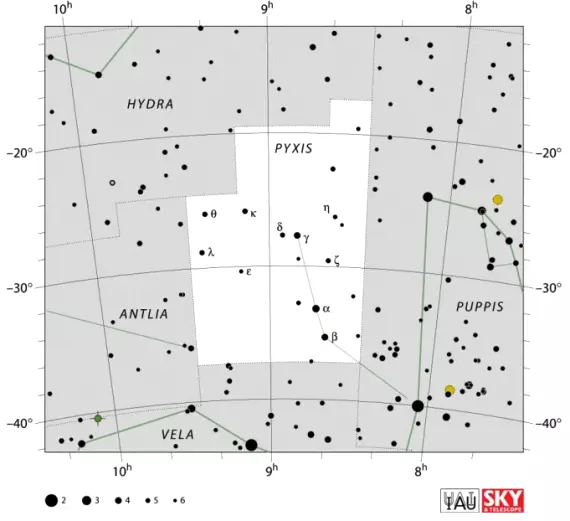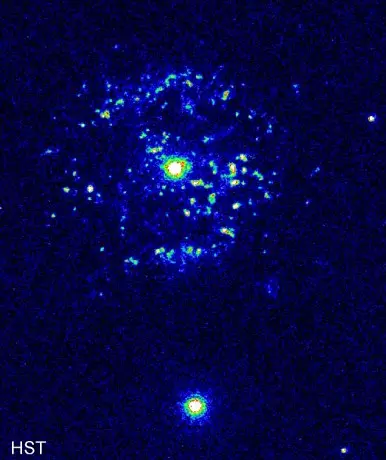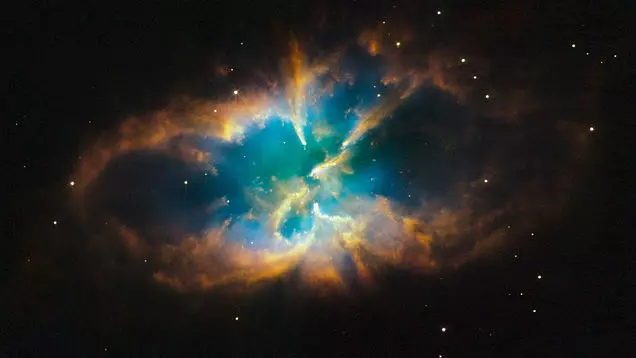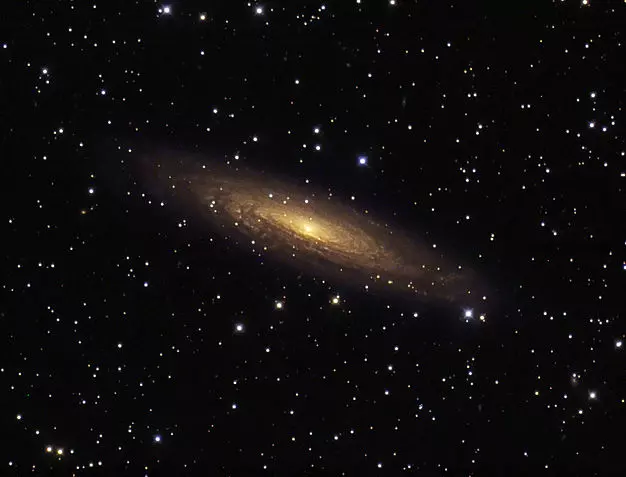Pyxis constellation lies in the southern sky. It represents a mariner’s compass. Pyxis was one of the constellations created by the French astronomer Nicolas Louis de Lacaille in the 18th century. Lacaille named the constellation Pyxis Nautica, but the name was later simplified to Pyxis.
Pyxis lies near the former constellation Argo Navis, which represented the Argonauts’ ship in Greek mythology, but was eventually broken into several smaller constellations. Pyxis is sometimes taken to represent the ship’s compass, but unlike Argo Navis, it was not one of the Greek constellations.
Pyxis contains several notable deep sky objects, including the planetary nebula NGC 2818, the open cluster NGC 2627, and the barred spiral galaxy NGC 2613.
Facts, location and map
Pyxis is the 65th constellation in size, occupying an area of 221 square degrees. It is located in the second quadrant of the southern hemisphere (SQ2) and can be seen at latitudes between +50° and -90°. The neighboring constellations are Antlia, Hydra, Puppis and Vela.
The constellation name Pyxis is pronounced /ˈpɪksɪs/. In English, the constellation is known as the Compass. The genitive form of Pyxis, used in star names, is Pyxidis (pronunciation: /ˈpɪksɪdɪs/). The three-letter abbreviation, adopted by the International Astronomical Union (IAU) in 1922, is Pyx.
Pyxis belongs to the Heavenly Waters family of constellations, along with Carina, Columba, Delphinus, Equuleus, Eridanus, Piscis Austrinus, Puppis and Vela.
Pyxis contains three stars with known planets and has no Messier objects. The brightest star in the constellation is Alpha Pyxidis, with an apparent magnitude of 3.68.
Pyxis does not contain any named stars. There are no meteor showers associated with the constellation.

Pyxis constellation map by IAU and Sky&Telescope magazine
Story
The constellation Pyxis was created by the French astronomer Nicolas Louis de Lacaille in 1751-52 during his exploration of the southern skies. He named the constellation la Boussole and later Latinized the name to Pixis Nautica. The constellation appeared under this name in the second edition of Lacaille’s chart in 1763. The name was eventually shortened to Pyxis.
The constellation represents the magnetic compass used by navigators and seamen and should not be confused with Circinus, which was named after a draftsman’s compass. Pyxis lies in the vicinity of the three constellations that were once known as Argo Navis, a single large constellation that represented the ship of Jason and the Argonauts.
Lacaille was the one who divided Argo Navis into three smaller ones – Carina, Puppis and Vela – and this might be the reason why Pyxis is sometimes mentioned as the fourth constellation that was part of Argo Navis, even though it was not. The Greek astronomer Ptolemy had catalogued the stars from Alpha to Delta Pyxidis, but not as part of Argo Navis, but as stars located on or around the ship’s mast.
In 1844, the English astronomer John Herschel suggested that the name Pyxis be replaced with Malus, the mast. This would have made the constellation a subdivision of Argo Navis if Herschel’s suggestion had been accepted, but it was not. The International Astronomical Union (IAU) eventually adopted Pyxis as one of the 88 modern constellations.
Pyxis stars
α Pyxidis (Alpha Pyxidis)
Alpha Pyxidis is a giant star of the spectral type B1.5III. It has an apparent magnitude of 3.67 and is approximately 880 light years distant. The star is classified as a Beta Cephei variable, which means that variations in its brightness are a result of pulsations of the star’s surface.
Alpha Pyxidis has more than 10 solar masses and a radius six times that of the Sun. It is about 10,000 times more luminous than the Sun and will eventually end its life as a supernova.
β Pyxidis (Beta Pyxidis)
Beta Pyxidis is a binary star with a combined apparent magnitude of 3.954, about 420 light years distant from the Sun. It is the second brightest star in Pyxis.
The star has a spectral classification G7Ib-II, which means that it is either a bright giant or supergiant, yellowish in colour. It has 28 times the Sun’s radius. It has a magnitude 12.5 visual companion located 12.7 arc seconds away.
γ Pyxidis (Gamma Pyxidis)
Gamma Pyxidis is an orange giant of the spectral type K3III. It has a visual magnitude of 4.026 and is approximately 209 light years distant. It is the third brightest star in the constellation.
T Pyxidis
T Pyxidis is a binary star composed of a star similar to the Sun and a white dwarf. It usually has a visual magnitude of 15.5, but being a recurrent nova, when it erupts, the magnitude can go up to 6.4. There are currently only ten recurrent novae known. T Pyxidis was observed erupting in 1890, 1902, 1920, 1944, 1966 and 2011.
The two stars in the T Pyxidis system lie close together and the white dwarf draws mass off the Sun-like star, which causes the periodic eruptions.
T Pyxidis is at least about 10,388 light years (3,185 parsecs) distant from Earth. Evidence suggests that the star has increased in mass despite the eruptions and that it might soon end its life as a Type 1a supernova, the kind that occurs when a white dwarf in a binary system reignites and triggers a supernova event. T Pyxidis is expected to go supernova at some point in the next 10 million years. The event will likely not affect life on Earth because star is too distant for the supernova to significantly damage our ozone layer.

Hubble telescope picture of T Pyxidis, from a compilation of data taken on Feb. 26, 1994, and June 16, Oct. 7, and Nov. 10, 1995, by the Wide Field and Planetary Camera 2. Image: Mike Shara, Bob Williams, and David Zurek (Space Telescope Science Institute); Roberto Gilmozzi (European Southern Observatory); Dina Prialnik (Tel Aviv University); and NASA
κ Pyxidis (Kappa Pyxidis)
Kappa Pyxidis is a multiple star with the spectral classification K4/K5III. The brightest component in the system is an orange giant. The system has a combined apparent magnitude of 4.62 and is 487 light years distant. It will come within 306 light years of the Sun in about 2.6 million years, and brighten to magnitude 3.34.
θ Pyxidis (Theta Pyxidis)
Theta Pyxidis is a red giant of the spectral type M0III. It has a visual magnitude of 4.71 and is about 522 light years distant. About 5.8 million years ago, the star came within 241 light years of the Sun and had an apparent magnitude of 3.12.
ζ Pyxidis (Zeta Pyxidis)
Zeta Pyxidis is another multiple star in Pyxis. The brightest component is a yellow giant star of the spectral type G5III, about 236 light years distant from the Sun.
δ Pyxidis (Delta Pyxidis)
Delta Pyxidis is also a multiple star. It has an apparent magnitude of 4.87 and is 226 light years distant. The primary component in the system is a white subgiant of the spectral type A3IV.
Deep sky objects in Pyxis
NGC 2818
NGC 2818 is a planetary nebula in Pyxis, created when a star in its final stages ejected its outer layers, which now appear as glowing gases. The remnant of the central star’s core remains as a white dwarf.
The nebula is 3.25 light years in radius and lies about 10,400 light years from the solar system.

A Hubble Space Telescope photo of the planetary nebula NGC 2818, one of few planetary nebulae in the Milky Way residing inside a star cluster, image: NASA, ESA, and the Hubble Heritage Team
NGC 2627
NGC 2627 is an open cluster in Pyxis. It contains about 40 stars with magnitudes ranging from 11 to 13. The cluster has a visual magnitude of 8.4 and is about 8000 light years distant. The cluster is located to the south-west of Zeta Pyxidis.
NGC 2613
NGC 2613 is a barred spiral galaxy, seen almost edge-on. It is believed to resemble our galaxy, the Milky Way. It has an apparent magnitude of 10.6 and is approximately 60 million light years distant.

NGC 2613, image: ESO, IDA, Danish 1.5 m, R. Gendler, J.-E. Ovaldsen, C. Thöne and C. Féron